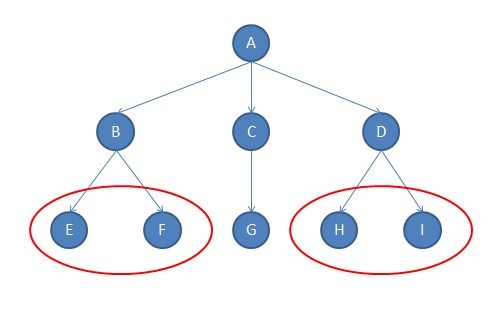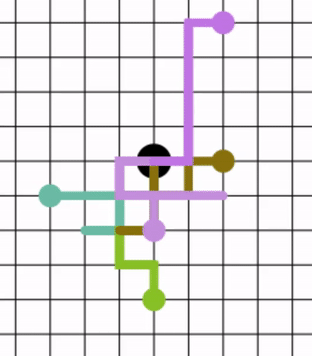|
Struc2vec
struc2vec is a framework to generate node vector representations on a graph that preserve the structural identity. In contrast to ''node2vec'', that optimizes node embeddings so that nearby nodes in the graph have similar embedding, ''struc2vec'' captures the roles of nodes in a graph, even if structurally similar nodes are far apart in the graph. It learns low-dimensional representations for nodes in a graph, generating random walks through a constructed multi-layer graph starting at each graph node. It is useful for machine learning applications where the downstream application is more related with the structural equivalence of the nodes (e.g., it can be used to detect nodes in networks with similar functions, such as interns in the social network of a corporation). ''struc2vec'' identifies nodes that play a similar role based solely on the structure of the graph, for example computing the structural identity of individuals in social networks. In particular, ''struc2vec'' empl ... [...More Info...] [...Related Items...] OR: [Wikipedia] [Google] [Baidu] |
Node2vec
node2vec is an algorithm to generate vector representations of nodes on a graph. The ''node2vec'' framework learns low-dimensional representations for nodes in a graph through the use of random walks through a graph starting at a target node. It is useful for a variety of machine learning applications. Besides reducing the engineering effort, representations learned by the algorithm lead to greater predictive power. ''node2vec'' follows the intuition that random walks through a graph can be treated like sentences in a corpus. Each node in a graph is treated like an individual word, and a random walk is treated as a sentence. By feeding these "sentences" into a skip-gram, or by using the continuous bag of words model paths found by random walks can be treated as sentences, and traditional data-mining techniques for documents can be used. The algorithm generalizes prior work which is based on rigid notions of network neighborhoods, and argues that the added flexibility in exploring ne ... [...More Info...] [...Related Items...] OR: [Wikipedia] [Google] [Baidu] |
Graph Theory
In mathematics, graph theory is the study of '' graphs'', which are mathematical structures used to model pairwise relations between objects. A graph in this context is made up of '' vertices'' (also called ''nodes'' or ''points'') which are connected by ''edges'' (also called ''links'' or ''lines''). A distinction is made between undirected graphs, where edges link two vertices symmetrically, and directed graphs, where edges link two vertices asymmetrically. Graphs are one of the principal objects of study in discrete mathematics. Definitions Definitions in graph theory vary. The following are some of the more basic ways of defining graphs and related mathematical structures. Graph In one restricted but very common sense of the term, a graph is an ordered pair G=(V,E) comprising: * V, a set of vertices (also called nodes or points); * E \subseteq \, a set of edges (also called links or lines), which are unordered pairs of vertices (that is, an edge is associated with t ... [...More Info...] [...Related Items...] OR: [Wikipedia] [Google] [Baidu] |
Similarity (network Science)
Similarity in network analysis occurs when two nodes (or other more elaborate structures) fall in the same equivalence class. There are three fundamental approaches to constructing measures of network similarity: structural equivalence, automorphic equivalence, and regular equivalence.Newman, M.E.J. 2010. ''Networks: An Introduction.'' Oxford, UK: Oxford University Press. There is a hierarchy of the three equivalence concepts: any set of structural equivalences are also automorphic and regular equivalences. Any set of automorphic equivalences are also regular equivalences. Not all regular equivalences are necessarily automorphic or structural; and not all automorphic equivalences are necessarily structural. Visualizing similarity and distance Clustering tools Agglomerative Hierarchical clustering of nodes on the basis of the similarity of their profiles of ties to other nodes provides a joining tree or Dendrogram that visualizes the degree of similarity among cases - and c ... [...More Info...] [...Related Items...] OR: [Wikipedia] [Google] [Baidu] |
Random Walk
In mathematics, a random walk is a random process that describes a path that consists of a succession of random steps on some mathematical space. An elementary example of a random walk is the random walk on the integer number line \mathbb Z which starts at 0, and at each step moves +1 or −1 with equal probability. Other examples include the path traced by a molecule as it travels in a liquid or a gas (see Brownian motion), the search path of a foraging animal, or the price of a fluctuating stock and the financial status of a gambler. Random walks have applications to engineering and many scientific fields including ecology, psychology, computer science, physics, chemistry, biology, economics, and sociology. The term ''random walk'' was first introduced by Karl Pearson in 1905. Lattice random walk A popular random walk model is that of a random walk on a regular lattice, where at each step the location jumps to another site according to some probability distribution. ... [...More Info...] [...Related Items...] OR: [Wikipedia] [Google] [Baidu] |
Multidimensional Network
In network theory, multidimensional networks, a special type of ''multilayer network'', are networks with multiple kinds of relations. Increasingly sophisticated attempts to model real-world systems as multidimensional networks have yielded valuable insight in the fields of social network analysis, economics, urban and international transport, ecology, psychology, medicine, biology, commerce, climatology, physics, computational neuroscience, operations management, and finance. Terminology The rapid exploration of complex networks in recent years has been dogged by a lack of standardized naming conventions, as various groups use overlapping and contradictory terminology to describe specific network configurations (e.g., multiplex, multilayer, multilevel, multidimensional, multirelational, interconnected). Formally, multidimensional networks are edge-labeled multigraphs. The term "fully multidimensional" has also been used to refer to a multipartite edge-labeled multigraph. Multidi ... [...More Info...] [...Related Items...] OR: [Wikipedia] [Google] [Baidu] |
Machine Learning
Machine learning (ML) is a field of inquiry devoted to understanding and building methods that 'learn', that is, methods that leverage data to improve performance on some set of tasks. It is seen as a part of artificial intelligence. Machine learning algorithms build a model based on sample data, known as training data, in order to make predictions or decisions without being explicitly programmed to do so. Machine learning algorithms are used in a wide variety of applications, such as in medicine, email filtering, speech recognition, agriculture, and computer vision, where it is difficult or unfeasible to develop conventional algorithms to perform the needed tasks.Hu, J.; Niu, H.; Carrasco, J.; Lennox, B.; Arvin, F.,Voronoi-Based Multi-Robot Autonomous Exploration in Unknown Environments via Deep Reinforcement Learning IEEE Transactions on Vehicular Technology, 2020. A subset of machine learning is closely related to computational statistics, which focuses on making pred ... [...More Info...] [...Related Items...] OR: [Wikipedia] [Google] [Baidu] |
Social Network
A social network is a social structure made up of a set of social actors (such as individuals or organizations), sets of dyadic ties, and other social interactions between actors. The social network perspective provides a set of methods for analyzing the structure of whole social entities as well as a variety of theories explaining the patterns observed in these structures. The study of these structures uses social network analysis to identify local and global patterns, locate influential entities, and examine network dynamics. Social networks and the analysis of them is an inherently interdisciplinary academic field which emerged from social psychology, sociology, statistics, and graph theory. Georg Simmel authored early structural theories in sociology emphasizing the dynamics of triads and "web of group affiliations". Jacob Moreno is credited with developing the first sociograms in the 1930s to study interpersonal relationships. These approaches were mathematically for ... [...More Info...] [...Related Items...] OR: [Wikipedia] [Google] [Baidu] |
Gensim
Gensim is an open-source library for unsupervised topic modeling, document indexing, retrieval by similarity, and other natural language processing Natural language processing (NLP) is an interdisciplinary subfield of linguistics, computer science, and artificial intelligence concerned with the interactions between computers and human language, in particular how to program computers to pro ... functionalities, using modern statistical machine learning. Gensim is implemented in Python and Cython for performance. Gensim is designed to handle large text collections using data streaming and incremental online algorithms, which differentiates it from most other machine learning software packages that target only in-memory processing. Main Features Gensim includes streamed parallelized implementations of fastText, word2vec and doc2vec algorithms, as well as latent semantic analysis (LSA, LSI, SVD), non-negative matrix factorization (NMF), latent Dirichlet allocation (L ... [...More Info...] [...Related Items...] OR: [Wikipedia] [Google] [Baidu] |
Word2vec
Word2vec is a technique for natural language processing (NLP) published in 2013. The word2vec algorithm uses a neural network model to learn word associations from a large corpus of text. Once trained, such a model can detect synonymous words or suggest additional words for a partial sentence. As the name implies, word2vec represents each distinct word with a particular list of numbers called a vector. The vectors are chosen carefully such that they capture the semantic and syntactic qualities of words; as such, a simple mathematical function (cosine similarity) can indicate the level of semantic similarity between the words represented by those vectors. Approach Word2vec is a group of related models that are used to produce word embeddings. These models are shallow, two-layer neural networks that are trained to reconstruct linguistic contexts of words. Word2vec takes as its input a large corpus of text and produces a vector space, typically of several hundred dimensions, with eac ... [...More Info...] [...Related Items...] OR: [Wikipedia] [Google] [Baidu] |




